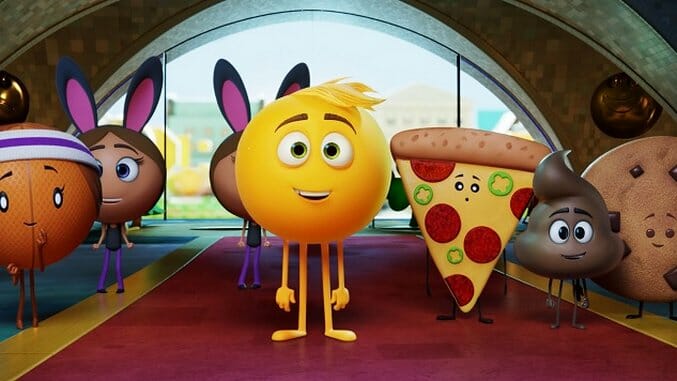The Emoji Movie

The Emoji Movie’s most insidious trait is its surface-level innocuousness. Admit it: You’re eyeballing the film’s colorful TV spots as you fast forward your way through your DVR’d shows, your brow furrowed, your conscience baffled but untroubled. “It looks stupid,” you’re reassuring yourself, “but it’s probably harmless.” But that’s The Emoji Movie’s greatest trick: It’s gaudy and goofy enough to convince you, at a glance, that it’s harmless, similar to how the greatest trick the devil ever pulled was convincing the world he didn’t exist.
Well, let me tell you: The Emoji Movie exists, and it’s a big, dumb, dishonestly corporate pox on all strains of culture, whether popular or technological. Sony Pictures Animation’s bright, carefree, earnestly juvenile marketing for the film suggests innocent if idiotic children’s fare—the sort of picture you’re doomed to bring your kids to see for lack of better options (or any options, really). But these elements, readily displayed in the film’s trailers, veil its true purpose as wanton product placement. If you listen closely, you can hear the sound of money changing hands in the background as mobile, web-based platforms like Youtube and Spotify are each name-dropped as a necessary function of The Emoji Movie’s plot. (If you’re wondering why a film adapted from your text message history needs plot, you’re giving it more thought than it deserves.)
There’s a little bit of Inside Out in The Emoji Movie’s story, a little bit of The Lego Movie and much more of Sausage Party than you’d either expect or prefer. (If it must be said aloud: Sausage Party is a horrifying movie.) The setting is Textopolis, a digital burg located within the smartphone of a teenage boy named Alex (Jake T. Austin). It’s the emoji capital, the place where every emoji lives, works and does the one single thing that they’re programmed to do, whether smile, laugh, cry, or act angry. Or, in the case of the movie’s hero, Gene (T.J. Miller), act ambivalent. Except Gene isn’t ambivalent at all! He likes to smile, laugh, cry, go nuts at the sight of adorable babies, and generally be “himself,” which the film blandly, generally defines as “be a stock slacker male protagonist.” There’s nothing measurably special about Gene, so the movie goes out of its way to tell us that there is, and we keep waiting to see it.
Gene’s non-emoji conforming identity ends up causing massive problems at the scanning center in Textopolis, where emoji wait for their user to send a text and then have their image uploaded to his screen. (Think of it as a government job that everyone has. It’s every bit as convoluted and half-assed as it sounds.) Because Sony needs to justify The Emoji Movie’s green-lighting through conflict, the head emoji, Smiler (Maya Rudolph), sends a swarm of anti-virus killbots to erase Gene. Gene, in turn, gets the hell out of Textopolis with a high-five emoji, voiced by James Corden, and searches for a hacker emoji named Jailbreak, voiced by Anna Faris, because she can reprogram him to just be the “meh” emoji he was born to be. Cue a stock narrative about finding oneself in a society where individuality is deemphasized in favor of uniformity.
-

-

-

-

-

-

-

-

-

-

-

-

-

-

-

-

-

-

-

-

-

-

-

-

-

-

-

-

-

-

-

-

-

-

-

-

-

-

-

-








































